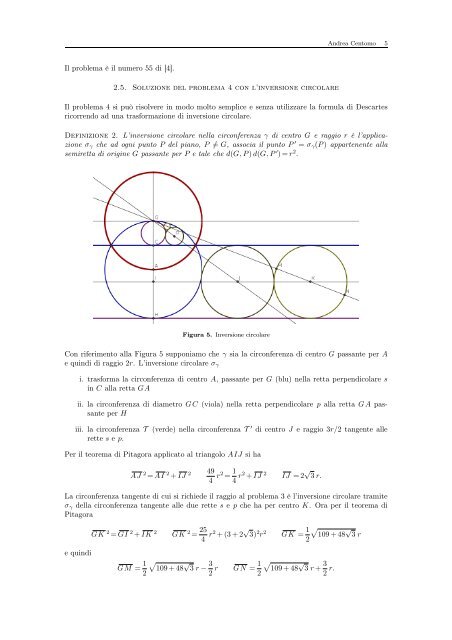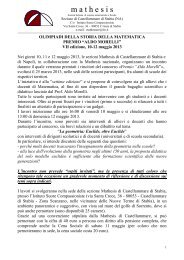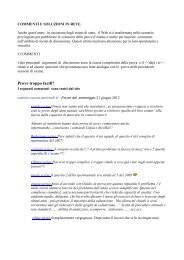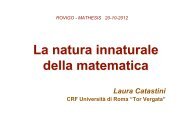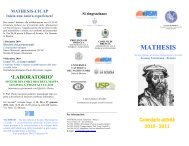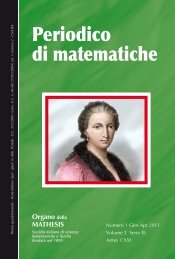Un ventaglio di problemi giapponesi per il liceo scientifico - Mathesis
Un ventaglio di problemi giapponesi per il liceo scientifico - Mathesis
Un ventaglio di problemi giapponesi per il liceo scientifico - Mathesis
Create successful ePaper yourself
Turn your PDF publications into a flip-book with our unique Google optimized e-Paper software.
Il problema è <strong>il</strong> numero 55 <strong>di</strong> [4].<br />
2.5. Soluzione del problema 4 con l’inversione circolare<br />
Il problema 4 si può risolvere in modo molto semplice e senza ut<strong>il</strong>izzare la formula <strong>di</strong> Descartes<br />
ricorrendo ad una trasformazione <strong>di</strong> inversione circolare.<br />
Definizione 2. L’inversione circolare nella circonferenza γ <strong>di</strong> centro G e raggio r è l’applicazione<br />
σγ che ad ogni punto P del piano, P G, associa <strong>il</strong> punto P ′ = σγ(P) appartenente alla<br />
semiretta <strong>di</strong> origine G passante <strong>per</strong> P e tale che d(G,P)d(G,P ′ )=r 2 .<br />
Figura 5. Inversione circolare<br />
Con riferimento alla Figura 5 supponiamo che γ sia la circonferenza <strong>di</strong> centro G passante <strong>per</strong> A<br />
e quin<strong>di</strong> <strong>di</strong> raggio 2r. L’inversione circolare σγ<br />
i. trasforma la circonferenza <strong>di</strong> centro A, passante <strong>per</strong> G (blu) nella retta <strong>per</strong>pen<strong>di</strong>colare s<br />
in C alla retta GA<br />
ii. la circonferenza <strong>di</strong> <strong>di</strong>ametro GC (viola) nella retta <strong>per</strong>pen<strong>di</strong>colare p alla retta GA passante<br />
<strong>per</strong> H<br />
iii. la circonferenza T (verde) nella circonferenza T ′ <strong>di</strong> centro J e raggio 3r/2 tangente alle<br />
rette s e p.<br />
Per <strong>il</strong> teorema <strong>di</strong> Pitagora applicato al triangolo AIJ si ha<br />
AJ 2 =AI 2 +IJ 2<br />
49<br />
4 r2 = 1<br />
4 r2 +IJ 2 IJ =2 3<br />
√ r.<br />
La circonferenza tangente <strong>di</strong> cui si richiede <strong>il</strong> raggio al problema 3 è l’inversione circolare tramite<br />
σγ della circonferenza tangente alle due rette s e p che ha <strong>per</strong> centro K. Ora <strong>per</strong> <strong>il</strong> teorema <strong>di</strong><br />
Pitagora<br />
e quin<strong>di</strong><br />
GK 2 =GI 2 +IK 2 GK 2 = 25<br />
4 r2 +(3+2 3<br />
GM = 1<br />
109+48 3<br />
2<br />
√ <br />
r− 3 1<br />
r GN =<br />
2 2<br />
√ ) 2r2 GK = 1<br />
109+48 3<br />
2<br />
√ <br />
109+48 3<br />
√ <br />
r+ 3<br />
2 r.<br />
Andrea Centomo 5<br />
r


